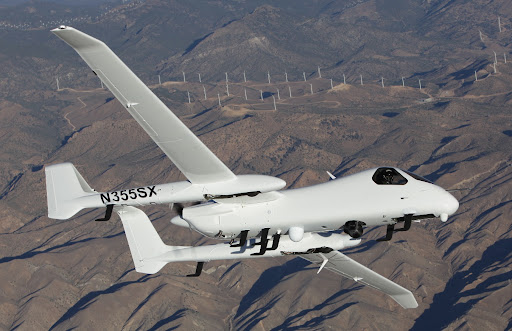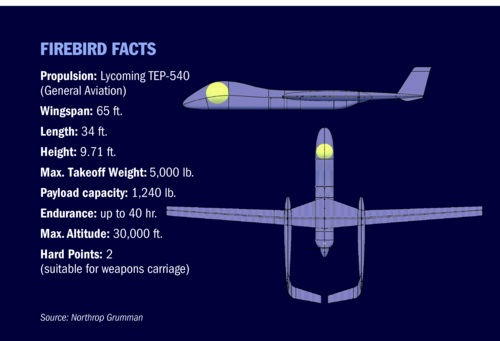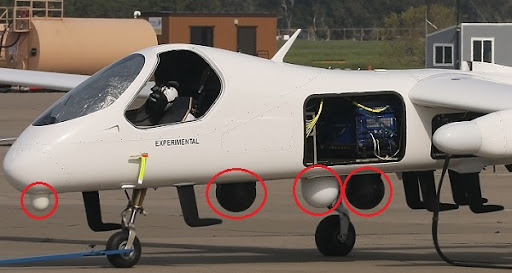I'm extremely interested to see Northrop Grumman's new entry in the increasingly crowded field of unmanned aerial vehicles. It's not that this aircraft offers major new capabilities - although it looks to be at least as competent as its equivalents from other manufacturers - but it packages them in a way that may make it much more competitive on the international market.
Ares reports:
The U.S. medium-altitude, long-endurance (MALE) UAS market is large, with General Atomics earning hundreds of millions of dollar’s of work annually, previously for the Predator and now - with Predator out of production - for the Air Force Reaper and Army Gray Eagle. "That was a target," says Paul Meyer, director of Northrop Grumman’s Advanced Technology and Concepts division, referring to the MALE market. "That is the one that is unopposed today [but] when we looked at it, we needed to do something different."
Firebird is an optionally piloted vehicle built by Northrop Grumman’s Scaled Composites in 12 months.Northrop Grumman Firebird (click the image for a larger view).
Note the numerous aerials and sensor turrets beneath the aircraft and tail booms.
First flown in February 2010, Firebird is the first publicly unveiled aircraft product of Meyer’s organization, which was formed about two years ago. Previously, Northrop had advanced concepts experts at each company location. "It was an adjunct arm of the operating business," Meyer says. Now, forward-looking design work is a stand-alone function headquartered in Redondo Beach, Calif.
The twin-boom, Bronco tail design can carry up to four sensor payloads simultaneously and Firebird’s information architecture was crafted to offer users in disparate locations direct access to those sensors. The forward-swept wings, combined with other aircraft attributes, are designed for loitering and collecting intelligence and they also offer the ability to climb and dash to another target area if needed, company officials say. The aircraft is designed to fly at about 200 kt.
The heart of Firebird, however, is not the aircraft but the information technology architecture, says Rick Crooks, director of special programs at the company’s advanced concepts division. The aircraft and sensor command-and-control systems are rooted in 10 years of work to develop an open architecture amenable to quick payload switches, he says.
. . .
The design, which has an endurance of 40 hr., depending on the payload and mission, could also provide an alternative to the Pentagon’s growing fleets of manned HawkerBeechcraft King Air 350 and 350ERs. The Air Force has purchased 37 MC-12W Project Liberty aircraft, which are modified to carry various intelligence payloads. And the Army also has a diverse fleet of similar aircraft. Meyer suggests the goal for Northrop Grumman was to design a basic truck that would allow for customers to focus spending on sensors. Typical mission duration for the King Airs operating in the field today is 4-6 hr.
. . .
This month, Northrop intends to showcase for the first time the use of up to four payloads simultaneously and rapidly integrated onto the aircraft during Empire Challenge, which runs May 23 ‑ June 3. They are slated to include a mix of electronic support/direction finding, EO / IR (including short- and mid-wave infrared and high-definition FMV), radar and a communications relay. The goal is to demonstrate multiple missions during the same sortie (intelligence collection and communications relay), land the aircraft, reconfigure the sensor suite and launch within an hour. The sensors will be controlled by three geographically distinct users.View of Firebird deploying four under-fuselage sensor turrets
(circled in red), plus aerials and open fuselage electronics bay
Empire Challenge is hosted by the U.S. Joint Forces Command, and it is designed to demonstrate near-term capabilities that can be rapidly deployed. The aircraft will fly out of Fort Huachuca, Ariz., for the exercise.
Northrop Grumman designed and built Firebird to be operationally ready; it is not considered a prototype, Crooks says.
. . .
Though the first Firebird carries a general aviation Lycoming TEP-540 engine, Northrop is examining alternatives. A heavy-fuel engine designed to work using the same fuel Army officials pump into trucks is a priority, and a search is ongoing for candidates.
The aircraft design also has two hard points, one on each wing, and a station on the centerline suitable for carrying weapons in the future. A radar has previously been tested on the centerline station.
There's more at the link.
Three things jump out at me about this new UAV.
- It's at the same level of size, power, etc. as General Atomics' MQ-1 Predator UAV and its more modern variant, the MQ-1C Grey Eagle. Both of the latter UAV's have proven extremely successful; and the Firebird, building upon all that's been learned from these programs, should potentially be at least as promising (probably more so, given its more modern systems architecture and greater sensor payload). The Predator's larger descendant, the MQ-9 Reaper, uses a much more powerful turboprop rather than a piston engine, and can therefore carry a much larger payload in terms of both sensors and weapons; but there's no reason why a turboprop-powered variant of the Firebird couldn't be produced, to do precisely the same thing.
- Being 'optionally piloted', the Firebird can sidestep the heated debate over how to integrate pilotless UAV's into a crowded civil airspace. There's a long-standing debate over how to accomplish this, with many pitfalls and obstacles to be overcome (particularly from a safety perspective). Simply by putting a pilot into the cockpit, the Firebird can navigate safely through civil airspace under the control of air traffic centers, allowing it to accomplish its mission with relatively few complications. It can also be ferried over long distances (even across oceans, if necessary) without worrying about loss of communication with the onboard systems (leading to loss of control, and possibly the loss of the aircraft).
- The most interesting aspect of Firebird, to me at any rate, is that it potentially sidesteps the obstacles to international sales posed by the Missile Technology Control Regime. Briefly, this accord prohibits the sale or transfer of missile or unmanned vehicle technology that would permit a 500kg. (1,100-pound) payload to be carried a distance of at least 300km. (187½ miles). The MTCR has blocked the sale of Predator, Grey Eagle and Reaper UAV's to several nations. However, Firebird, being optionally manned, can be sold to such nations as a piloted aircraft rather than a UAV - sidestepping the MTCR, whilst offering precisely the same capabilities as its unmanned competitors. Furthermore, thanks to its open systems architecture, even if they're not sold with the aircraft, pilotless capabilities can probably be rapidly and easily re-integrated with the systems on board by any country with the technological capability to do so. This would render the MTCR's restrictions meaningless.
I'll be watching Firebird's progress with great interest. This might be a very significant development. I wouldn't be surprised to see other companies (and countries, for that matter) follow Northrop Grumman's lead.
Peter



7 comments:
The Drone Wars, begun they have.
I can't figure out what those eight rearward-hooked appendages are on the bottom of the aircraft. Probably some kind of antennae, but for what?
Leatherneck
Leatherneck, I suspect they're aerial housings rather than aerials themselves. The shapes are aerodynamically efficient, and fairly large, which would leave a lot of room (relatively speaking) inside each one for a more specialized aerial to be mounted. It'd be shielded from the airstream, so it wouldn't have to be aerodynamically shaped itself, and it wouldn't need a high-strength mounting to the fuselage, to resist air pressure - provided it could fit into the black housing provided.
I think a couple of them would be reserved for ground-to-air communication, allowing patrols to interrogate the sensor feed from the aircraft to see what's in front of them. Others might be for communications intelligence, to intercept enemy signals.
(These are merely my guesses, of course. We'll have to wait for more information to emerge.)
It looks like a Burt Rutan design---or at least by a Rutan protege'.
Hint: Built by Scaled Composites.
@Roger: Yes, that was noted in the article.
Looks like the computer age grandson of the OV 10.
Post a Comment